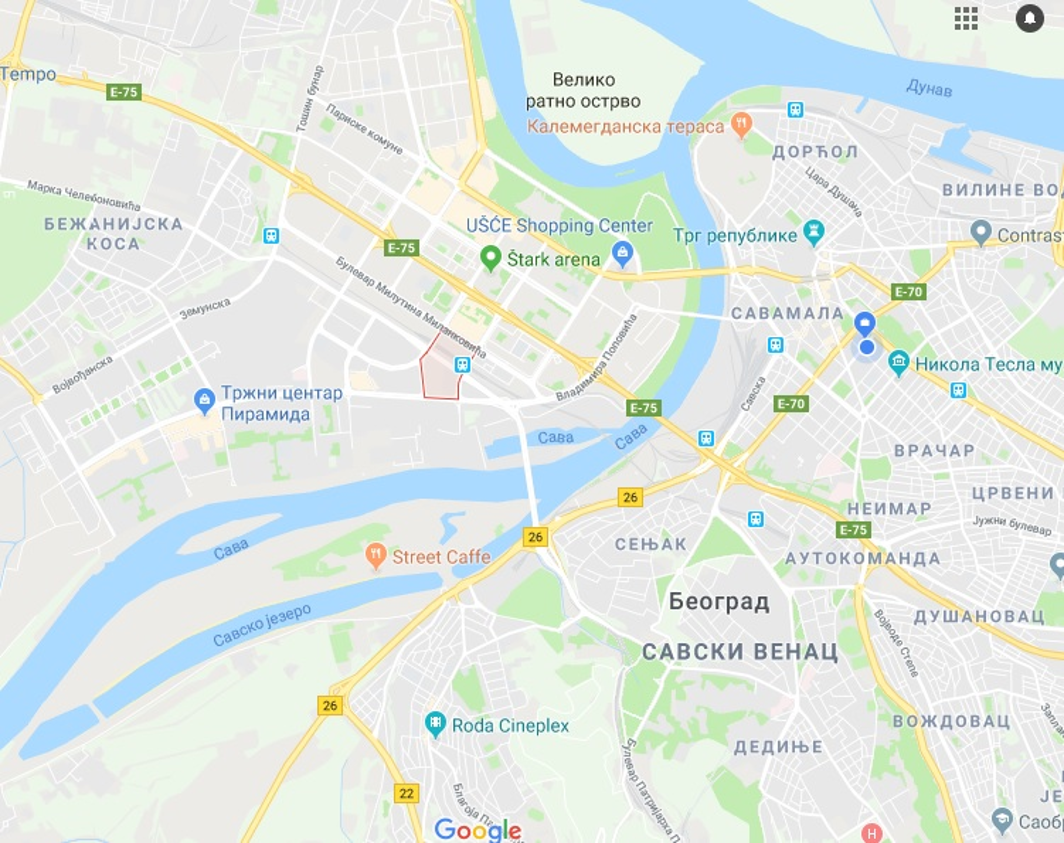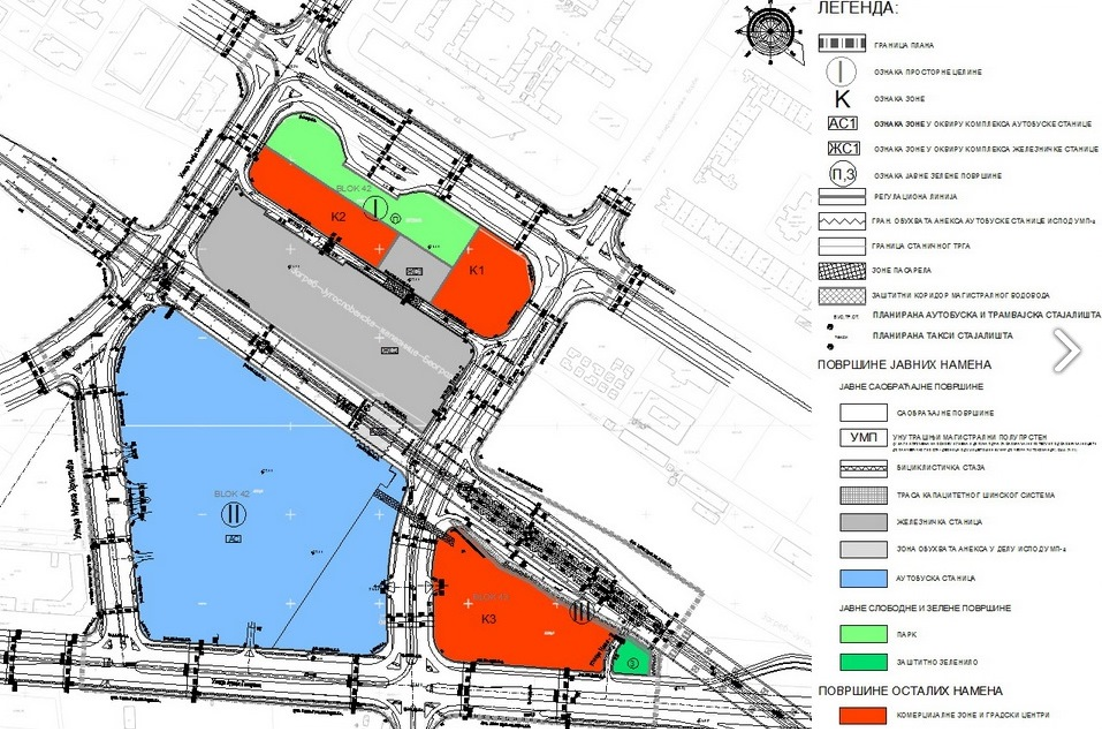Good Practices - Serbia
Railway station New Belgrade in the City of Belgrade
(railway integration with public bus and tramway system and car parking – existing situation and future additional integration with new inter-city and international bus station)
Main stakeholders of presented solution are City of Belgrade – Secretariat for Transport and Secretariat for Public Transport, Ministry of construction, transport and infrastructure, Serbian Railway infrastructure, Railway city company – Belgrade node, City public transport company, railway and bus operators, several City municipalities, citizens.
Existing Solution
Location of Railway station “New Belgrade” is in the middle of two most urban parts of municipality of New Belgrade, in block 42 at western part of City of Belgrade, on the left bank of Sava River. On one side of railway station direction there is a numerous blocks of residential buildings and on the opposite side mixed structure of blocks of residential buildings and business zone, representing a new business center of Belgrade and Serbia. This station is one of the several stations of Belgrade Railway node, a project started back in 70’s aiming to develop and integrate City Railway, intercity and international railway connections of the City of Belgrade.
Total population of New Belgrade Municipality is about 220.000 inhabitants, but together with other two municipalities at the left bank of Sava river, there are almost half a million population in direct gravity zone of railway station “New Belgrade”.
Railway station “New Belgrade” serves all types of passenger trains, from City railway “BG Voz” (meaning “Belgrade Train”) connecting sub-urban areas and Belgrade down town, inter-city trains connecting west, central and north parts of Serbia and international trains operating at Corridor 10.
At this moment, there are five rail tracks, merging into double tracks on both ends of station. All tracks are electrified.
In the past, railway station “New Belgrade” was not so busy regarding that main station in down town was operational, serving main international and intercity lines. Also, next to the station there was a huge open “flee market” and not so attractive location.
Today, after closure of main railway station in down town, railway station “New Belgrade” get a new dimension and more significant role. Also, flee market was cleaned and regulated by construction of City open mall. The station is very close to the new bridge over river of Sava, connecting New Belgrade and Downtown.
Integration of this railway station with public transit is not a new solution. It was projected and constructed back in 70’s- 80’s of the last century.
Solution was constructed and implemented through denivelation of railway tracks over the street where buses and tramways are passing. Latest integration of car parking was completed by transformation of flee market into open mall and construction of high capacity car parking near to public transit and railway station, enabling fast and easy transfer from individual car to public transit or railway and vice versa.
Railway station “New Belgrade” and car parking are next to 3 tramway lines (7,9,11) and one bus line (95), and near (less than 5 minutes of walk) to additional 4 bus lines (67, 85, 89, 94) enabling connection to all parts of the city (direct or by one transfer).
Using City Railway “BG: VOZ” it’s possible to reach 3 railway stations in city center as well as sub-urban areas - settlement “Batajnica” at the west and settlement “Ovča” at the north of the Belgrade.
Future Solution (construction works started)
According to available plan of detailed regulation and construction project of new Inter-city and international bus station and railway station in block 42, municipality of New Belgrade, fully integrated two stations with underground walking connection, integrated with public transport and park’n’ride system is projected. Completing of construction works are planned for 2020.
Existing situation

Position of block 42 (red area) – Railway station New Belgrade

Integration of park’n’ride with railway and public transit system

Schematic view on public transit lines and connections to railway system

Transfer from individual car to tramway lines
Future solution

Future land use: blue – bus station, grey – railway station, orange – commercial

Detailed regulation plan of new bus and railway stations

Cross section of new stations with underground walking connection
3. Challenges and barriers in implementing /introducing selected good practice and respective ways used in order to overcome or limit risks
Main barrier for full implementation of integrated railway station with public transit system, park and ride and inter-city bus station is lack of funds for construction.
Second, there was certain difficulties to achieve positive public opinion and public support for movement of bus and railway stations to new locations, mostly caused by daily politics and miss-understandings.
4. Funding mechanism, cooperation schemes developed and institutional reforms made
Partial solution for funds ensuring was found through joint funding by City of Belgrade who will ensure the land and Stock Company “Belgrade Bus Stations” who will finance construction of new Bus Station. Funding sources for new railway station is still unknown, but for sure, Belgrade Railway node and Serbian Railway Infrastructure Public companies will be involved.
3. Challenges and barriers in implementing /introducing selected good practice and respective ways used in order to overcome or limit risks
In case of railway station “New Belgrade” integration with public transport and park and ride, after many years of low level of use by citizens, main factors of success are increasing of service level and quality of railway line services.
On the other side, in terms of further development and construction of new bus station integrated with railway station, main factor of success is creating of funding mechanism through joint cooperation scheme of City of Belgrade and Stock Company “Belgrade Bus Stations”.
Still, regarding that intermodality applied in this example is aligned with EU policy in transport and city development, opportunity to use funds and experience of European Union through Instruments of Pre-Accession or similar, is missed.
By support of this instruments and funding mechanisms, integrated railway, bus and public transport systems would be closest to full implementation.
6. Recommendations, transferability
Even not fully implemented, example of integration of railway with public transport and park and ride system presented by this report, showing that it is possible to achieve good results without huge investments by good planning, increasing of quality of railway services, step-by-step implementation.